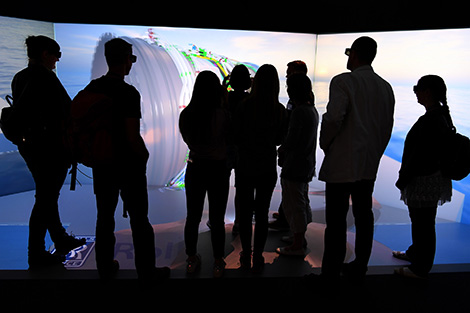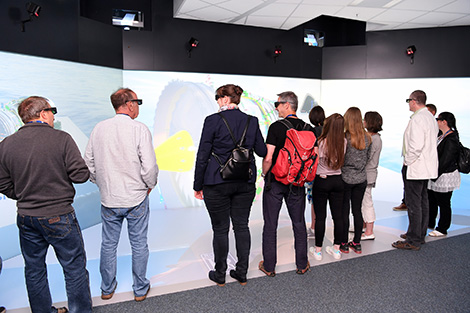
Rolls-Royce sees a positive future for using VR in its aerospace engineering – and is working with academic partners to develop new processes to merge simulation results with CAD geometry in real-time
Rolls-Royce Deutschland has huge CAD models, with the typical aero engine having around 20,000 components (ie. several massive gigabytes of data), right down to individual screws, so visualising them immersively, with a fluent frame rate, is no easy task.
“With such complicated and detailed models, we need to not just visualise in 3D, but also enable intuitive interaction (such as dynamic sections),” explained Prof. Dr Marius Swoboda, head of physical, computational and design sciences at Rolls-Royce.
The team, located in Blankenfelde just outside Berlin, has installed a bespoke 8.5-metre wide Virtalis ActiveCube display system, comprising of three walls, splayed at 130°, with an active floor.

Rolls-Royce has installed as 8.5-metre wide Virtalis ActiveCube display system, comprising of three walls, splayed at 130°, with an active floor
The more open configuration has allowed for better communication between the designers and engineers – as well as visiting politicians, suppliers, customers and joint project stakeholders.
The system runs Virtalis’ Visionary Render software, primarily to test new approaches to design and manufacture.
“Owing to the open architecture of our VR-System, we can visualise our digital product definition, provide interdisciplinary review sessions and check everything fits together as it should,” said Stephan Rogge, Rolls-Royce Deutschland’s VR operator and development engineer.
Capable of loading an entire engine model data set, Visionary Render is used handle complex geometry, including cut planes, and acts as a flexible development platform for Rolls-Royce.
Teams are able to move from stand-by to a fully loaded engine model in VR in ‘just five minutes’, while Rolls-Royce has also taken delivery of two Virtalis ActiveDesk HMD-based systems, used in addition to the ActiveCube.
“I see VR as a multi-disciplinary incubator of ideas,” stated Swoboda. “Our engineers come up with more ideas than they would in 2D because they clearly see the obstacles they face and what needs to be done to overcome them.
“They don’t need to have IT expertise because they just intuitively interact with the visualisation, such as physically walking round the model or pointing and dragging to make changes.”
As a further result, Rolls-Royce states that it is integrating Visionary Render into its business processes, including product familiarisation, factory planning and the creation of assembly sequence instructions for fitters.
Rolls-Royce is also collaborating with academic partners, like BTU Cottbus, to develop new processes to be able to merge simulation results with CAD geometry in real-time.
Additionally they are looking to improve the interface between humans and machines by using gestures, position and speech.






